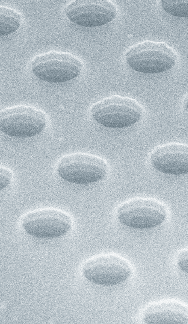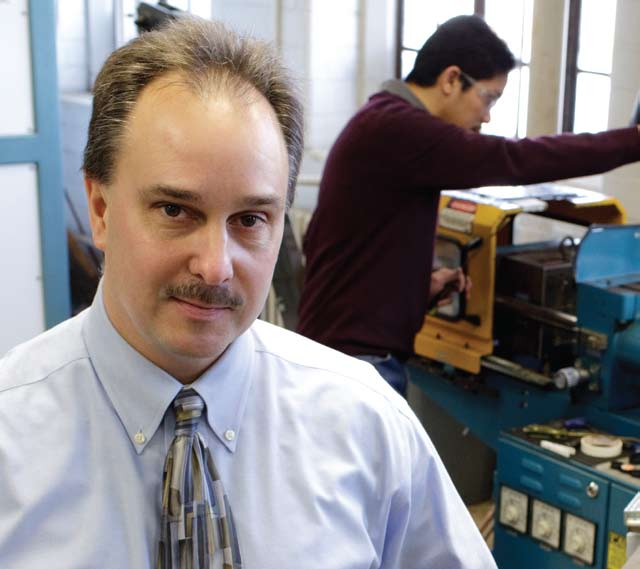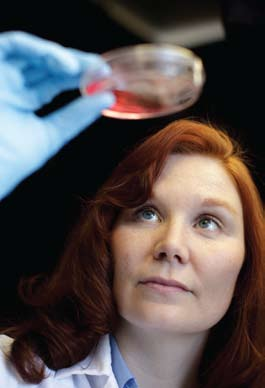Adult stem cells – undifferentiated cells that maintain and repair tissue in living organisms – have been studied for years. Scientists hope to coax the cells to differentiate, or form specific cell types, so they can be used in medical applications.
Controlling differentiation is a challenge, so scientists are seeking to grow and study adult stem cells in the laboratory. This endeavor stands to benefit from a fortuitous collaboration between Sabrina Jedlicka and John Coulter, who have grant proposals pending to develop the biochemically modified nanostructured surfaces required for stem cells to differentiate.
Jedlicka, an assistant professor of materials science and engineering, is working on biochemical ways to push adult stem cells to differentiate into mature tissues such as bone, muscle and brain. Coulter, a professor of mechanical engineering and mechanics, is internationally renowned for his work in nanoscale injection molding, which has been used in optical, biomedical, data storage and fluid mechanics applications.
Neither researcher knew of the other’s expertise until Coulter paid a visit to Jedlicka’s office in 2008, soon after she joined the Lehigh faculty. A few days later, they submitted their first proposal to NSF.
Their project holds great promise if they can solve a complex problem – the design of nanostructured substrates and media conditions to facilitate the consistent growth and differentiation of various types of stem cells.
To date, scientists have isolated stem cells or precursor cells and implanted them directly at the site of disease. The premise is that the body will direct these cells into new, mature, healthy tissue. But the human body does not always stimulate these cells appropriately, which can lead to failure of the therapy, implant rejection or even tumor formation.
“Scientists have reached a bottleneck,” Jedlicka says. “To move cell-based therapy forward as a widely available, safe treatment option, we need to be able to differentiate cells consistently by growing them under standardized conditions and on standardized surfaces.” This will not only lead to tissue regeneration in vitro for therapeutic purposes, but will also help scientists understand the complex biomolecular signaling that occurs during cell and tissue development.
Nano-tuned injection molding
Jedlicka and Coulter have developed what one might term “smart” petri dishes, or biochemically modified nanostructured surfaces, on which they grow a variety of stem cells. One type, human mesenchymal stem cells, is derived from bone marrow and is believed to be able to differentiate into many types of connective tissues in the body under appropriate activation conditions.
Coulter’s group, one of only two in the world that has produced nanomolded features as small as 50 nm in size, fabricates experimental substrates on which the cells grow. The nanoinjection molding process requires great precision and control. A silicon mold is first fabricated at Lehigh’s Sherman Fairchild Center for Solid-State Studies. Using electron-beam lithography, an electron beam controlled by a computer file exposes spots on the coating of the silicon, causing them to weaken. Plasma created by an ion-etching machine then eats away the weak regions of the coating and digs deeper into the silicon mold, creating the cavities that will form the pillars of the eventual polymer substrate.
There are more technical hurdles. The mold must be treated so the polymer injected into it doesn’t stick, and the silicon mold must be protected from breaking under the high pressure exerted during injection molding. Coulter’s group has solved these challenges by applying anti-stiction coatings to silicon mold inserts that are then incorporated into a larger brass mold base prior to injection molding.
Finally, the polymer must fill the mold entirely. In typical injection molding, molten polymer is deposited into a cold mold and freezes instantly. If this is done with extremely small features, however, not all the channels in the mold would fill completely. To fabricate nanoscale features, Coulter’s group dynamically controls the local mold temperature and temporarily heats the mold hotter than the polymer. The polymer then flows unimpeded and is cooled immediately after it is poured.
After the nanostructured substrate is fabricated, Jedlicka prepares it for cell culture studies and places cells on it to grow. She is working on a chemical technique to modify the structures with critical protein-derived peptides to support cell adhesion and trigger differentiation signaling.
As the cells differentiate, Jedlicka examines them microscopically for morphology changes. At various points during the cycle, she does biochemical testing. This typically involves immunocytochemistry, in which researchers use antibodies to “tag” a protein of interest and view it with fluorescence microscopy. Each cell type has a different protein signature that varies throughout development. For example, neurons are known to uniquely express a cytoskeletal protein known as ß-tubulin III.
The nanostructures that Jedlicka and Coulter make have a material stiffness that approaches the physiological stiffness of the desired tissue in vivo. When the structures are modified with biochemicals similar to those with which the cells interact in the body, they develop into an environment with the appropriate mechanical, topographical and chemical cues. Modifying the nanoscale feature size and biochemistry makes these surfaces “tunable” to any desired cell application.
Imagine a bed of nails, says Jedlicka, and you can envision what these minute surfaces look like. Thousands of tiny plastic pillars make up the surface, and they are made stiff to produce bone tissue, less stiff for muscle and soft for neurons.
“We hope to develop a selection of these smart petri dishes, each variety with a different nanopillar geometry and biochemistry,” she says, “so that a scientist who wants to make neurons can choose the dish with the longest, softest pillars modified with the laminin peptides critical for neuronal growth. Lehigh is one of the few places that can actually develop the technology to make these surfaces in large volume and at relatively low cost.”
After biochemical testing demonstrates that a cell has become a cell of interest, functional testing ensures that it is becoming more mature than it would on a traditional petri dish. For neurons, this will include electrophysiological testing, neurotransmitter release characterization and synapse examination.
“Our goal is to consistently push the cells into a more mature, defined state than can be currently achieved,” Jedlicka says.



